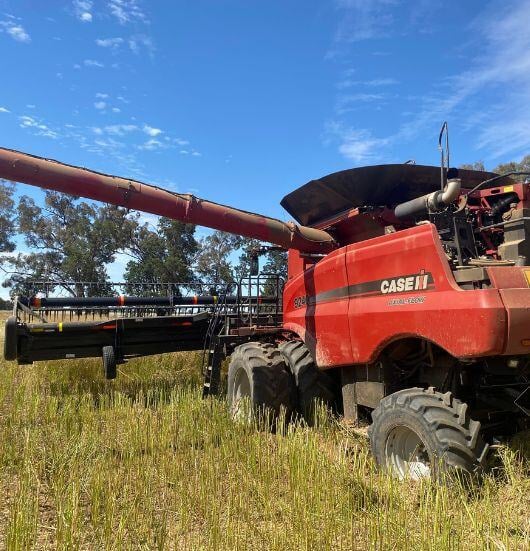Issues that arise with rain during harvest
Rain during harvest presents one of the most frustrating and challenging scenarios for grain growers. In this blog, we examine key issues including trafficability, risks to grain quality, and potential fire hazards.

Key messages
- Paddock trafficability may be an issue as growers look to finish harvest before Christmas
- Use a germination test to assess the viability of seed grain harvested after rain and monitor conditions closely during storage
- Machinery fire risk may be higher following rain, as dust sticks to machines more readily
The untimely arrival of rain at harvest can cause a range of operational and quality issues, impacting both yield and profitability. From bogged machinery, reduced grain quality and disease risks, wet conditions can quickly turn harvest into a logistical and financial headache.
Grain and seed quality
Rain during harvest can cause a reduction in grain quality when the grain (seed) starts the germination process while still in the head . As grain begins to germinate, the starch and protein levels drop and alpha-amylase levels rise. Because alpha-amylase is a protein that breaks down starch, and grain with less starch makes poorer quality flour, this often leads to grain quality downgrades. To measure alpha-amylase, grain receival sites will use the Falling number test. Higher quality grain will generally have a falling number of more than 300 seconds. Learn more about the falling numbers test.
Weather damaged grain that was going to be kept for seed needs to be closely monitored for signs of germination and deterioration. Ideally seed would be harvested before any rain events occur, however if this was not possible, monitor the seed closely for signs of sprouting and disease. A germination test should be performed at harvest, during storage and prior to sowing to ensure that the seed is viable (provided the seed dries out before the embryo starts to grow, the seed could still be viable for sowing). Germination percentage of 80 per cent at seeding is considered acceptable, however the germination percentage should be higher when testing at harvest. Learn more on seed quality.
Paddock trafficability and completing safe recovery
Paddock trafficability will be an issue for many in the next few weeks, as we wait for the rain to stop and paddocks to dry out so harvest can be finished. If you find yourself in a sticky situation and get a piece of large machinery, tractor and chaser bin, header or truck, is so important to stop and assess the situation before acting.
Ensure all your recovery gear is in good condition, and rated well above what you require (ideally double). Use an old tyre through a snatch strap as a dampener in case of failure. Use a soft shackle in place of a metal D-ring if you can source one. Ensure all by-standers are standing well clear before attempting a recovery and communicate clearly using your UHF radios.
Fire risk
Ironically, rain can also exacerbate fire risks when damp crop debris and dust sticks to harvesters. As machinery heats up during operation, this debris can ignite, leading to fires that pose risks to equipment, operators, and the crop itself.
Follow these tips to reduce risk of harvester fires;
- Clean down machines regularly to prevent build of flammable material
- Try to harvest into the wind when possible to reduce residue build up on the header
- A laser temperature gun is a useful tool to monitor bearings, brakes, exhaust and other high risk areas
- Double check all fire extinguishers are in place and charged.
Conclusion
Amidst the pressures of wet harvest conditions, it’s crucial not to compromise safety in the rush to complete harvest. Taking shortcuts or pushing equipment and operators to their limits can lead to accidents or costly breakdowns. A steady, calculated approach, with safety as a top priority, ensures that the harvest operations are managed efficiently and responsibly.
Resources
Wet harvest implications and resources | GRDC
Wheat grain quality, falling number and pre-harvest sprouting resistance | WA DPI
Retaining seed factsheet | GRDC
Retaining weather damaged seed | Riverine Plains
Safely recovering bogged machinery | GRDC
Managing risks bogged farm machinery | Worksafe Victoria
Preparing for wet conditions during harvest | Riverine Plains
Hot headers: how to reduce fire risk | NSW farmers
Ten tips to reduce risk of harvester fires this season | GRDC
Author
Lynn Macaulay
Member Engagement Officer Bachelor of Agriculture and Farm Business Management
5 December 2024
NEWS
Discover unique perspectives on agriculture from across the Riverine Plains.
-
Livestock
-
People
-
Grains
-
Sustainability

